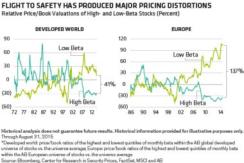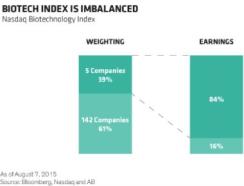After years of steadily rising markets, distortions have become embedded in the landscape. We believe there are several large market imbalances that investors may be exposed to in passive portfolios today.
Market distortions develop for many reasons. Benchmarks can become heavily concentrated in a popular sector or region. Valuations may reflect fleeting fads instead of the true economic worth of a company. But the good news is that by detecting imbalances in global equity markets today, investors can take steps to avoid trouble spots.
Safety commands a big premium today. Although nearly seven years have passed since the beginning of the 2008–’09 global financial crisis, bouts of turmoil still trigger defensive reactions from investors. As a result, there’s a 41-percentage-point spread between the relative price-to-book-value ratios of global low-beta stocks, which are generally perceived as safer, and their riskier high-beta peers (see chart 1, left). That’s a wider spread of valuations versus the broad market than we’ve seen 90 percent of the time since 1972.

It’s even more pronounced in Europe. As the Greek crisis has compounded fears that the region is inherently riskier than others, the valuation gap between high- and low-beta stocks has widened to 137 percentage points (see chart 1, right) — the widest by far since 1986. In other words, investors are paying a huge premium to the market — and three times the price of the highest-beta cohort — for European stocks that are considered safer but might ultimately prove to be very risky if the safety trade reverses.
Asia also faces a quality bubble, which has been reinforced by recent volatility in China. The most profitable fifth of companies in Asia (excluding Japan) trade at a record 3.3 times higher than the least profitable fifth of companies, exceeding the premium during the global financial crisis. From a regional perspective over the past few years, Southeast Asian countries, which are generally considered safer, have performed much better than northern Asian ones, which are considered riskier. We think investors in the region are paying too big a premium for earnings quality.
More broadly, emerging markets present particular challenges. For example, public equity markets include a high concentration of government-owned companies. In China 61 percent of companies listed on the Shanghai composite index are at least 20 percent owned by the government. In Russia they make up 48 percent of the benchmark.
The problem is that government-owned companies are often poorly run, as the Petrobras scandal in Brazil reminds us. Yet investors in stocks that are based on an emerging-markets index will be stuck with many government-held companies by default.
Commodities are another sensitive point. Many developing countries, including Brazil, Russia and South Africa, are big commodity exporters. In fact, 11 commodity-dependent countries account for about one third of the entire MSCI emerging-markets index. So if you invest in components of the index, you’ll be tied up with large weightings in countries that are directly affected by what could be a prolonged commodities slump.
Back in the U.S., the biotech industry also looks bubbly. So, what happens if an investor wants to get a piece of the exciting developments in biotech via an exchange-traded fund that includes 147 companies? First, the investor is buying an index in which 57 percent of the companies are unprofitable. Second, the top five companies account for 39 percent of the index — and their earnings represent 84 percent of the total (see chart 2).

The Nasdaq biotech index encompasses two main types of companies: a profitable group of established businesses and a more speculative collection of smaller companies. Both can be good investments. But owning all of them without scrutiny is risky. Instead, we recommend focusing on select companies with clear advantages in promising areas, while paying close attention to valuation to capture the sector’s tremendous growth potential.
Finding undervalued stocks through an index or smart-beta approach presents different problems. Value stocks today are heavily concentrated in financials and energy. For example, in the Russell 1000 Value index, financial companies as of July 31 accounted for 30 percent of the benchmark, and energy accounted for 12 percent. If we isolate the cheapest quintile of U.S. equities overall, 62 percent are financial stocks, and 15 percent are in energy.
This means that investors deploying a passive or smart-beta approach to invest in value stocks may be heavily exposed to financial firms and energy groups, instead of holding a portfolio with diversified return drivers. Of course, there are opportunities in each of these sectors. But in our view at AllianceBernstein, indiscriminate exposure to sectors facing significant challenges is fraught with risk.
Passive portfolios are important. But we think they should be combined with high-conviction equity strategies that can identify imbalances and take selective positions in stocks that offer the strongest return potential to circumvent traps across stock markets.
Sharon Fay is head and CIO of equities at AllianceBernstein in New York.
See AllianceBernstein’s disclaimer.
Get more on equities.






